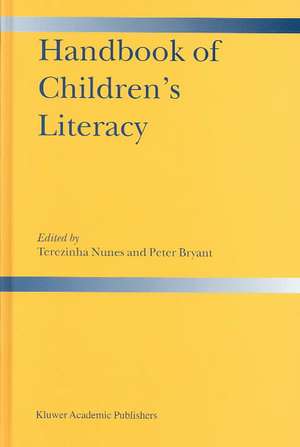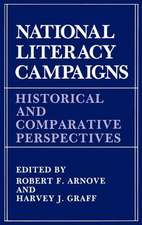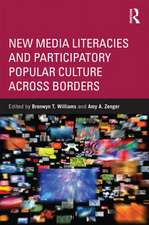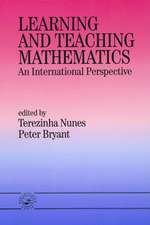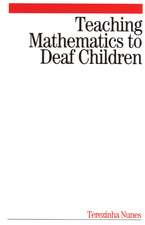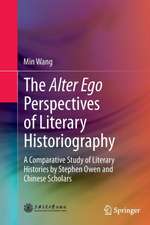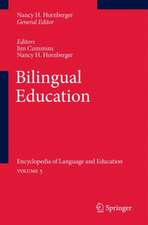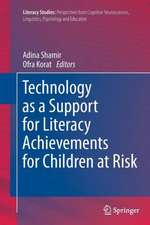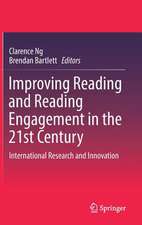Handbook of Children’s Literacy
Editat de Terezinha Nunes, Peter Bryanten Limba Engleză Hardback – 31 dec 2003
| Toate formatele și edițiile | Preț | Express |
|---|---|---|
| Paperback (1) | 1948.54 lei 6-8 săpt. | |
| SPRINGER NETHERLANDS – 8 oct 2011 | 1948.54 lei 6-8 săpt. | |
| Hardback (1) | 2774.07 lei 6-8 săpt. | |
| SPRINGER NETHERLANDS – 31 dec 2003 | 2774.07 lei 6-8 săpt. |
Preț: 2774.07 lei
Preț vechi: 3383.01 lei
-18% Nou
Puncte Express: 4161
Preț estimativ în valută:
530.99€ • 557.85$ • 446.24£
530.99€ • 557.85$ • 446.24£
Carte tipărită la comandă
Livrare economică 12-26 martie
Preluare comenzi: 021 569.72.76
Specificații
ISBN-13: 9781402016202
ISBN-10: 1402016204
Pagini: 790
Ilustrații: X, 790 p.
Dimensiuni: 155 x 235 x 38 mm
Greutate: 1.35 kg
Ediția:2004
Editura: SPRINGER NETHERLANDS
Colecția Springer
Locul publicării:Dordrecht, Netherlands
ISBN-10: 1402016204
Pagini: 790
Ilustrații: X, 790 p.
Dimensiuni: 155 x 235 x 38 mm
Greutate: 1.35 kg
Ediția:2004
Editura: SPRINGER NETHERLANDS
Colecția Springer
Locul publicării:Dordrecht, Netherlands
Public țintă
Professional/practitionerCuprins
Al. Childhood Conceptions of Literacy.- A2. Phonology and Spelling.- A3. Linguistic Processes in Reading and Spelling: The Case of Alphabetic Writing Systems: English, French, German and Spanish.- A4. Connectionist Models of Children’s Reading.- A5. Morphology and Spelling.- A6. Children’s Self-Perception as Readers.- B1. The Development of Comprehension Skills.- B2. Text and Cognition.- B3. The Use of Context in Learning to Read.- B4. Reading Stories.- B5. Computers and Writing.- Cl. Reading and Spelling Difficulties.- C2. The Concept of Dyslexia.- C3. Developmental Dyslexia: Evidence from Brain Research.- C4. Epidemiology: Genetic and Social Influences on Reading Ability.- C5. Reading Comprehension Difficulties.- C6. Early Identification.- C7. Early Intervention.- C8. Individual Differences in Dyslexia.- C9. Specific Speech and Language Difficulties and Literacy.- C10. Reading by Touch in Blind Children and Adults.- C11. Deafness and Reading.- Introduction: Teaching Literacy: What Practices, When and Why?.- D1. Literacy in Time and Space: Issues, Concepts and Definitions.- D2. Teaching Reading: A Historical Approach.- D3. The Cognitive Consequences of Literacy.- D4. Comparative Studies of Instructional Methods.- D5. Early Emergent Literacy.- D6. The Linguistic Consequences of Literacy.- El. Phonological Awareness and Learning to Read: A Cross-Linguistic Perspective.- E2. Morphology, Reading and Spelling: Looking Across Languages.- E3. Bilingualism and Reading.- E4. Grammatical Awareness Across Languages and the Role of Social Context: Evidence from English and Hebrew.- E5. Literacy, Socialisation and the Social Order.- E6. Segmentation in the Writing of Mayan Language Statements by Indigenous Children with Primary Schooling.- E7. Paths to Literacy for Deaf BritishSign Language (BSL) Users.
Textul de pe ultima copertă
The Handbook of Children’s Literacy provides a unique collection of papers, offering a multi-perspective, multi-disciplinary approach to understanding alphabetic literacy. The analyses at word, text and cultural levels offer an integrative view of literacy. Basic research, theoretical advances, investigations in the classroom, analyses of literacy acquisition by readers with special needs, cross-linguistic comparisons and a historical and cultural perspective will enrich the understanding of literacy of academics and practitioners alike. This is a rare opportunity to consider literacy in breadth and depth by consulting a single collection. The contributing authors are distinguished experts in their domain of investigation, teacher educators and teachers in sixteen different countries.
Caracteristici
The multi-disciplinary, multi-cultural view of literacy and the different levels of analysis are unique in this handbook.
